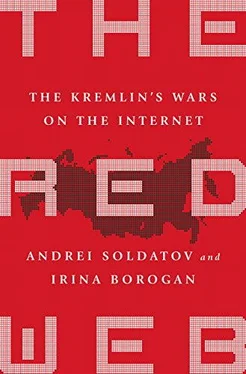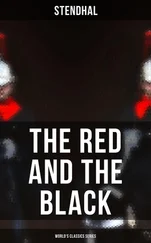The debates on TV Dozhd started on October 1 and lasted for almost three weeks. It proved to be a huge success for the channel. “Our evening news traditionally got the highest rating. And now we saw, wow, our rating rise higher at midnight,” said Zygar. Saprykin, who was a cohost on air, recalled that there was a chance that all hell would break loose with so many different views. But contrary to that fear, the opposition was allowed a voice on television, “and nothing awful happened,” he said. [26] Yuri Saprykin, “O teledebatakh na Dozhde” [On the TV Debates at Dozhd], Rambler-Afisha , October 17, 2012, http://gorod.afisha.ru/archive/sluchai-saprykin-teledebaty .
Russians got their first political debate since the 1990s.
The Kremlin seemed to ignore both the shows and the opposition council.
Then, on November 1, the Ministry of Communications launched the single register of banned websites—the blacklist. And then even more pressure was put on the activists. Nossik was summoned for an interrogation on November 16 because he had helped launch the website of the opposition council’s elections; in response, in November he left LiveJournal. The same month Lev Gershenzon left Yandex.ru, explaining that he was in charge of Yandex News and for years tried to improve the algorithms of selecting the news while also fighting the pressure from the authorities. But by the end of 2012 he realized that algorithms, however sophisticated and clever, could not resolve a new problem—that it had become increasingly difficult to see differences among the various reports of various media, most of which had started to present a uniform and identical picture. Here the technology was helpless.
The protests convinced the Kremlin that the approach to the Internet developed in the 2000s, a combination of DDOS attacks and trolls, didn’t work when tens of thousands of people went to the streets. So the Kremlin decided to put the Internet under control by technical means, through filtering. It was essentially a nationwide censorship, but the Kremlin didn’t copy the Soviet example, when censorship was conducted by a government body, Glavlit, with representatives in every Soviet publication.
The actual day-to-day business of Internet filtering was not assigned to FSB officers nor to the officials of Roskomnadzor, a relatively small government agency with no more than a few dozen personnel tasked to deal with the Internet. Roskomnadzor selected what should be censored, but it fell to ISPs and telecom operators to implement the blacklists. To make the system work across the country, the filtering system required a lot of people, and there are thousands of ISPs in Russia. The specialists needed technical training, had to comply with orders, no questions asked, and they had to protect the secrecy of operations because Roskomnadzor deemed the blacklists of banned websites secret.
Russia had plenty of such specialists.
CHAPTER 9
“We Just Come Up with the Hardware”
On the evening of May 27, 2011, a soccer match was about to be held in Moscow between Anzhi, a visiting team from Dagestan, and Lokomotiv, a popular Moscow team. The game was set for early evening so fans could come after work to the modern Lokomotiv home stadium that accommodates twenty-eight thousand in the east of the city. The visiting team, Anzhi, was generously funded by a wealthy oligarch and enjoyed crowds of enthusiastic fans. More than fifteen hundred of them arrived at Lokomotiv stadium that evening from Dagestan to see their team play. They were almost entirely men in their twenties and thirties who wanted to sit together, and they were required to use a separate entrance with high security. They arrived at the gate, holding tickets, and approached what looked to be a rather unremarkable metal detector and some city police. The visitors were from the North Caucasus, where Russia had fought two wars against rebels in Chechnya, so their arrival in Moscow was met with a apprehension and scrutiny. The police routinely patted them down, looking for weapons.
The fans coming through paid little attention to a camera sitting on a tripod aimed at each of them as they stepped up to the metal detector. The lens was aimed at their faces. The camera rapidly attempted to capture each face into a green digital frame and then identified different characteristics of the face, including such distinctive features as distance between the eyes. Then the camera went to work, snapping several photographs of each face. A computer connected to the camera then evaluated each person based on a complex algorithm, and within seconds the person’s name was established and they were given a unique number. They may have all come to see a soccer match, but they had also just walked into a modern and potentially powerful system of face recognition. Originally invented to help spot criminals, face recognition had expanded in the hands of security services to be a tool for surveillance of all kinds of people at any kind of public event and in public places.
Near the metal detectors sat an operator with a laptop who worked for a company called Ladakom-Service, and he monitored every face closely. One window on his screen showed the live camera acquiring the face images, another part of the screen showed the captured images, and a program was constantly running to match the captured images with people in a government passport database, one of the biggest in the country. When the match was successful, a photograph just taken appeared along the bottom of the screen with the person’s full identity. The government had obtained a current picture and identification of thousands of people that could be used for almost any purpose in the future.
It happened not only at sports events. The same company in 2011 had installed this technology in the entrance hall of one of the busiest metro stations in the city. The station, Okhotny Ryad, is located a stone’s throw from the Kremlin and around the corner from the Russian lower house of parliament, next to one of the most heavily traveled streets in Moscow. As people stepped on the subway escalator, their faces entered a frame and were captured by video cameras. The images were rapidly linked to their identity in security service databases. There was no notification to anyone that they were being recorded.
The system was so advanced that a scan of 10 million images would take no more than seven seconds. The facial images and video are sent to the Metro system’s situation room, the Interior and Emergencies Ministries, and to the FSB.
The facial recognition system is a glimpse into a large and mostly hidden phenomenon that was a profound legacy of the Soviet experience: the use of engineering to build systems for the security services to control information and populations. These systems were invented and developed by engineers who knew what the systems could do but rarely if ever questioned the purpose of control for which they were used.
The Soviet Communist Party held a monopoly on power and did not want competition. It imposed rigid conditions on all kinds of people; for engineers, there was pressure to conform to the goals of the party-state and to fulfill its technical needs. To succeed meant to work on projects without questioning the big picture. For many decades Soviet engineers were schooled intensively in technical subjects but rarely if ever had exposure to the humanities; the breadth of their education was exceedingly narrow. Unlike medical doctors who were trained in ethics, engineers were not. They were taught to be technical servants of the state. As a result, generations of engineers were trained and worked their entire lives with little understanding of politics or trust of politicians and were suspicious of public activity as a whole. These engineers were focused on the immense technical needs of the Soviet Union and were comfortable with the concept of strict order because it suited their understanding of the mechanical world better than the often-unruly reality of freedom.
Читать дальше












